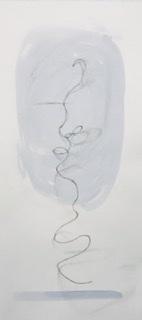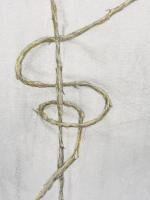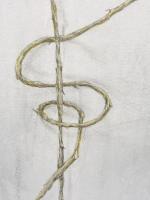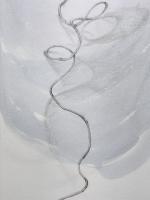Maryanna Adelman is an artist and arts educator living in Kansas City. With a focus in drawing, Maryanna creates observational pieces exploring the ambiguity between monumental vs. intimate and landscape vs. portrait. She has exhibited in the Kansas City area at the Nerman Museum of Contemporary Art, the Late Show Gallery, Kansas City Artists Coalition, UMKC Gallery of Art and the Thornhill Art Gallery. Currently, Maryanna teaches drawing at the University of Central Missouri and is a visiting artist for Kansas City Young Audiences. Adelman's artwork is on display at the Blue Valley Library until April 21, 2022.
*
Introduce yourself and describe your medium and technique.
My name is Maryanna Adelman and I primarily draw. I also make collages, the occasional print, and I think about painting.
How has your practice changed over time?
Like many before me, I first encountered the discipline of drawing in school. The lessons of observational drawing learned from Tom Russell at Baker University, then Stanley Lewis and Wilber Niewald at the Kansas City Art Institute still ring true to me. Over time, my work moved in more expressive and experimental directions. However, drawing was always a way to problem solve specific issues and center myself, in general. More recently, I have circled back to observational drawing as my main focus.
My process has changed in another way recently. Two years ago I began to rent a studio space at the Kansas City Artists Coalition. This has allowed me to intensify my drawing practice and has freed up space in my home studio for other art making activities.
What themes do you pursue?
Recently, stray bits of vines, twigs and wire have caught my attention. As my eyes and pencil move slowly through the twists and turns, I began to realize that I was absorbed into a visual labyrinth. It wasn’t until well into this series of drawings that I realized how closely related they are to my previous motifs of sidewalks found along Brush Creek and in Gillham Park. The curved lines moving through space and objects are nearly identical. In addition, I have long been interested in observing and creating an ambiguity between monumental vs. intimate and landscape vs. portrait.

Who are other artists you look to for inspiration, and what about their work do you like?
Aside from my early mentors, long time influences include Giacometti, Cezanne, Lucian Freud, Richard Diebenkorn and the other Bay Area figurative painters. All of these artists work from observation. Their work is more about a record of their process rather than about the appearance of the final product. In my view, this produces an honesty in their work. Recently, I have begun to follow contemporary artists on Instagram. Through this platform I’ve encountered Helen Ward, April Coppini , Helen Gotlib, Joe Morzuch and Michael Wann. Again, there is an honesty to the observation in their work, whether it is a drawing, print or painting.
What is your most important artistic tool? Is there something you can’t live without in your studio?
My tools and materials are simple: an array of pencils, erasers, the occasional acrylic wash and Rives BFK paper. Of course, my most important tools are my eye and hand. I produce all of this work on a large, sturdy easel my father built for me many years ago. It feels good to connect to him through my use of it.
Please list 5-10 books, movies and/or music that currently inspire you?
I have always been a reader. I love the way a good novel pulls me in, and I see it come to life in my head. But more to the point, certain books have impacted my work and/or my practice: Most recently, Ninth Street Women by Mary Gabriel. It’s about Lee Krasner, Elaine de Kooning and others who were at the forefront of the post WWII art scene in New York. A Giacometti Portrait by James Lord. It chronicles the development of a single painting. And while it’s not specifically about art, Willa Cather’s Death Comes for the Archbishop has been a perennial favorite. It’s slow, episodic pace looks both backwards in time while examining the future of a life well spent.








